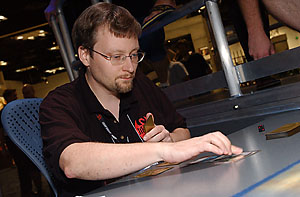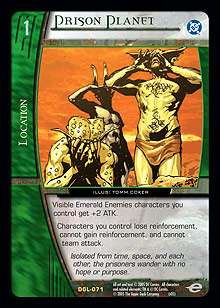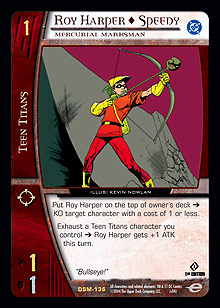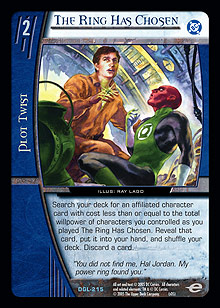
Another Pro Circuit is behind us, which signals the beginning of a new PCQ season for Metagame.com readers. Over the next few weeks, I’ll talk about the Superman and Green Lantern Modern Age format, as based on my team’s experiences testing for PC Indy.
Once again, a group of qualified players from Kings Games in Brooklyn, NY has teamed up with Boston’s Your Move Games to tackle this format’s playtesting. Working together has proven highly successful in the past, resulting in some innovative decks—such as Rigged Elections at the first PC Indy and MK Hounds in Amsterdam. We’ve tested a number of decks, and it was no surprise that we settled on GLEE (Green Lantern, Emerald Enemies) as our favorite. Having tested and quickly discarded a curve version of GLEE similar to the Kiwi Fruit deck that was successful in a Golden Age $10K in New Zealand, we settled on a super-aggressive off-curve variant originally proposed by PC Indy 2004 finalist Craig Edwards.
This was the first PC where the entire team ran the same deck, though the lists may have varied by a card or two. For this article, I will be using my own list, but I plan to discuss the alternations made by others. Our playtesting paid off well, as the combined KG/YMG squad sported the following results at the end of Day 1’s 12 rounds of play.
Rank Player Match Points
1 Shaheen, Anthony 11
8 Dougherty, Robert 9
13 Cuenca, Nick 9
16 Edwards, Craig 9
24 Crespo, Freddie 9
29 Corredor, Rick 9
31 O'Connell, Alex 8
35 Shvartsman, Alex 8
40 Rabinowitz, Jacob 8
62 Liu, Jason 8
75 Maderah, Eli 7
95 Pidgeon, Dustin 7
110 Cecchetti, Daniel 7
 Of the sixteen players who used our GLEE deck in Indianapolis, thirteen made it to Day 2—and only three of us did so with the minimum required win record. Anthony Shaheen navigated the deck to the #1 seat, with an 11-1 record.
Of the sixteen players who used our GLEE deck in Indianapolis, thirteen made it to Day 2—and only three of us did so with the minimum required win record. Anthony Shaheen navigated the deck to the #1 seat, with an 11-1 record.
Day 2 did not go as well for the KG/YMG conglomerate, but we still managed to place one player in the Top 8 (Rob Dougherty), three more in the top 20, and a total of eight people finished in the money! I did finish the tournament in 71st place after an abysmal 4-5 draft performance, but I still earned $640 to pay for my trip.
Here is the decklist that I played in Indianapolis.
Characters
2 Arisia, Green Lantern of Graxos IV
4 Dr. Light, Master of Holograms
1 Dr. Polaris, Dr. Neal Emerson
4 G'Nort, Green Lantern of G'Newt
1 Guy Gardner, Strong Arm of the Corps
1 Hector Hammond, Super-Futuristic Mind
1 Henry King Jr. ◊ Brainwave, Psionic Manipulator
3 Kyle Rayner, Last Green Lantern
2 Major Disaster, Paul Booker
3 Olapet, Green Lantern of Southern Goldstar
1 Rot Lop Fan, F-Sharp Bell of the Obsidian Deeps
2 Roy Harper ◊ Speedy, Mercurial Marksman
2 The Shark, T. S. Smith
3 Tomar Tu, Green Lantern of Xudar
Plot Twists
3 ¡Ole!, Construct
4 Hard-Traveling Heroes
1 No Evil Shall Escape Our Sight, Construct
3 Shock Troops
4 The Ring Has Chosen
2 Trial by Sword
Locations
4 Birthing Chamber
3 Prison Planet
4 Willworld
Equipment
1 Chopping Block, Construct
1 Light Armor, Construct
 It became apparent very early in our testing that a GLEE variant could beat just about any other deck we were able to put together in this format. The trick was to find ways of winning the mirror match. This is where our build differs from most others. We play Prison Planet and various ways to team up our characters, whereas most other builds either rely on Trial By Sword and Shock Troops, or add Helping Hand into the mix.
It became apparent very early in our testing that a GLEE variant could beat just about any other deck we were able to put together in this format. The trick was to find ways of winning the mirror match. This is where our build differs from most others. We play Prison Planet and various ways to team up our characters, whereas most other builds either rely on Trial By Sword and Shock Troops, or add Helping Hand into the mix.
The objective of this deck is to overwhelm an opponent with fast, efficient characters. Combining most of your cards with G'Nort and Arisia will easily allow your 1- and 2-drops to fight against the much larger characters that a curve-based deck might recruit, and there are no cards like Flame Trap or Overload in the format to punish such a strategy.
Let's look at every card individually and talk about why it belongs in the deck.
Characters
1-Drops
As this deck relies on overwhelming your opponent, you can never miss dropping a character. You simply must play a large number of 1-drop characters and will be forced to throw your opening hand away if you don’t have one.
 G’Nort, Green Lantern of G’Newt: Given a perfect draw, you will always play this character on the first turn. Since virtually every other character in the deck has willpower, G’Nort will make all of them larger. This is important in every matchup, and it becomes a huge advantage in the mirror match when you have the initiative. Typically one of your 2-drops will go after the opposing G’Nort, and once he is stunned, you can devastate the opposing side of the board while relatively few of your own characters will get stunned. You want to have G’Nort out on most turns, and it will often be your target when you boost an Olapet.
G’Nort, Green Lantern of G’Newt: Given a perfect draw, you will always play this character on the first turn. Since virtually every other character in the deck has willpower, G’Nort will make all of them larger. This is important in every matchup, and it becomes a huge advantage in the mirror match when you have the initiative. Typically one of your 2-drops will go after the opposing G’Nort, and once he is stunned, you can devastate the opposing side of the board while relatively few of your own characters will get stunned. You want to have G’Nort out on most turns, and it will often be your target when you boost an Olapet.
Arisia, Green Lantern of Graxos IV: Arisia is especially important in later turns when your low-cost characters have to fight against higher drops. Arisia is often capable of adding even more endurance loss during your attack step than G’Nort. She combos especially well with Olapet, who will be able to attack for an additional 6 endurance loss once you control 5 resources. Your other characters, such as Kyle Rayner, Last Green Lantern, can take down 3-drops with no help from plot twists or locations when Arisia is in play. Since Arisia isn't as helpful in the first couple of turns of the game, there are only two in the deck . . . but you’ll almost always want one in play in the later turns and can often use Olapet or even The Ring Has Chosen to go get her.
The Shark: Since most of your locations and plot twists will be flipped over almost immediately, The Shark can become very large very quickly. If you didn’t draw G’Nort, playing The Shark and flipping over Prison Planet to attack for 3 endurance loss on the first turn is your second-best play. When you have the option, you’d rather recruit The Shark on turns where you have the initiative, since it’s such a capable attacker, but its ability to stun back most characters that go after it is nothing to sneer at.
Henry King Jr. ◊ Brainwave, Psionic Manipulator: Since you can only have one of each type of character in play, you’ll often find yourself running out of characters to recruit. This extra character is there to help alleviate this problem, but his ability comes in handy, especially on turns when your opponent controls the initiative. Like most of the 1-drops in this deck, Henry King works especially well with Olapet. Against a Shadow Creatures deck, using the Henry King/Olapet combo is a key strategy in the later turns as you struggle to finish off the opponent.
 Roy Harper ◊ Speedy, Mercurial Marksman: This card is the only non-willpower character in the deck, the only character that does not share an Emerald Enemies or Green Lantern team affiliation, and the only card from the Superman, Man of Steel expansion. Speedy is also a key element in defeating both the GLEE and Shadow Creatures archetypes. A perfect opening for a GLEE deck is to recruit G’Nort, followed by a 2-drop Kyle Rayner, search for Chopping Block, recruit it on your G’Nort, attack with Kyle, and begin Chopping. Speedy puts an end to this plan by KO’ing the Block-wielding G’Nort.
Roy Harper ◊ Speedy, Mercurial Marksman: This card is the only non-willpower character in the deck, the only character that does not share an Emerald Enemies or Green Lantern team affiliation, and the only card from the Superman, Man of Steel expansion. Speedy is also a key element in defeating both the GLEE and Shadow Creatures archetypes. A perfect opening for a GLEE deck is to recruit G’Nort, followed by a 2-drop Kyle Rayner, search for Chopping Block, recruit it on your G’Nort, attack with Kyle, and begin Chopping. Speedy puts an end to this plan by KO’ing the Block-wielding G’Nort.
In the mirror match, there is no single more important 1-drop than Speedy. Ideally, you want to recruit him whenever your opponent controls the initiative, so that you can KO opposing G’Norts and Arisias and turn a potential bloodbath into merely an even contest. Speedy is also pretty good at aiming into the shadows to pick off Shadow Creatures and crippling the Anti-Monitor strategy early on. Although you cannot use Willworld on this card, you will often find yourself searching for it on turn 2 with The Ring Has Chosen.
Stupid Speedy Trick #1: Remember that KO’ing Speedy is not an activated ability, so you can attack first, and use it later.
Stupid Speedy Trick #2: You can exhaust Speedy to give himself +1 ATK to help stun a character that is attacking him.
Stupid Speedy Trick #3: Putting Speedy on top of your deck is a cost, so if you and your opponent each control Speedy as your only 1-drop, the active player can use their Speedy ability first to KO an opposing Speedy, and the opponent won’t be able to do anything about it.
2-Drops
Kyle Rayner, Last Green Lantern: An optimal second-turn play in most situations, Kyle can search out a number of useful cards, like ¡Ole!, Light Armor, and Chopping Block. If you have the even initiative (and you should always choose it when you win the die roll), you will usually go after Chopping Block. Otherwise ¡Ole! is a more practical choice in the mirror, while you will want the extra damage of Light Armor in other matchups. Kyle’s ability will activate when you bring him back into play with Dr. Light, Master of Holograms as well, so you should be able to gain significant card advantage as long as you can make sure that Kyle is among the casualties of combat every turn.
 Tomar Tu, Green Lantern of Xudar: If I had to summarize the mirror match strategy for GLEE in one sentence, it would simply be this: You must continually strive to control more characters than your opponent. This is why you’re going for the Chopping Block strategy, and this is also why you want to prevent your opponent from successfully implementing it against you. Tomar Tu’s ability to protect characters is very important. It will usually play bodyguard to G’Nort, Dr. Light, or sometimes even Arisia. You would be surprised to learn just to what degree Tomar Tu throws off a player’s attack math, even in later turns. All that, and you still get a 3 ATK/2 DEF character with flight and range for your 2 resource points.
Tomar Tu, Green Lantern of Xudar: If I had to summarize the mirror match strategy for GLEE in one sentence, it would simply be this: You must continually strive to control more characters than your opponent. This is why you’re going for the Chopping Block strategy, and this is also why you want to prevent your opponent from successfully implementing it against you. Tomar Tu’s ability to protect characters is very important. It will usually play bodyguard to G’Nort, Dr. Light, or sometimes even Arisia. You would be surprised to learn just to what degree Tomar Tu throws off a player’s attack math, even in later turns. All that, and you still get a 3 ATK/2 DEF character with flight and range for your 2 resource points.
Major Disaster, Paul Booker: Major Disaster’s ability to replace your opponent’s (and sometimes your own) Prison Planet, as well as other annoying locations, is one reason to play this character. Its 3 DEF value is another. Major Disaster can stun Kyle and not stun back unless an opponent uses up a plot twist, and this is pretty important in the mirror match. On rare occasions, you will also find yourself with an empty KO’d pile on turn 3, leaving Dr. Light bored and cranky. Major Disaster is another way to get your characters into the bin.
Hector Hammond, Super-Futuristic Mind: You never want to see Hector in play on turn 2, but he’s a perfect Dr. Light target on turns 5 and later. A natural 6 ATK/6 DEF even before G’Nort, Arisia, or Prison Planet bonuses, Hector Hammond will be one of your late-game MVPs.
Olapet, Green Lantern of Southern Goldstar: Don’t believe the little number at the top right of this card—it’s really a 3-drop! You will rarely want to recruit Olapet without boost. Olapet is your alternate turn 3 play if you fail to draw Dr. Light. Olapet is also your best turn 4 play, except in the Anti Monitor matchup, where you want to recruit Rot Lop Fan instead. You will usually get G’Nort, but sometimes you might want to grab Arisia. On a rare occasion, you’ll want to get Henry King or The Shark—but don’t forget that you can only grab those cards after you have a team-up card in play.
3-Drops
Dr. Light, Master of Holograms: This is undoubtedly the most important card in the deck. In fact, the archetype would not exist without him. It’s Dr. Light’s job to put an extra character into play for you every single turn. And it’s your job to make sure you can recruit Dr. Light on turn 3 in every single game. There are plenty of deck manipulation cards available that will let you find him—just make sure that you never discard Dr. Light over something else. In fact, if you’re reasonably sure that your opponent is playing with KO effects, you’ll need to hang on to a second copy of the good doctor.
Dr. Polaris, Dr. Neal Emerson: Your optimal turn 5 play includes him and either one 2-drop or a pair of 1-drops. You don’t normally want to recruit Guy Gardner, Strong Arm of the Corps on turn 5, especially if you don’t control the initiative. Guy is the ideal turn 6 play instead. Dr. Polaris comes in especially handy against decks with hidden characters, as he can exhaust them during his attack. Although you will find yourself occasionally boosting Dr. Polaris, it isn’t really part of the plan, and you should only do so if there’s a lack of other things to spend your resource points on. Having Polaris in play also allows you to target the two Doctors with ¡Ole! or Shock Troops.
The Big Guys
 Rot Lop Fan, F-Sharp Bell of the Obsidian Deeps: There is only one reason why this character is in the deck—you want him against the Anti-Matter strategy. The ability to attack hidden characters is a huge boon in that matchup, and you will almost always want to recruit Rot Lop Fan against them on turn 4. Otherwise, you can play the deck as though he doesn’t exist.
Rot Lop Fan, F-Sharp Bell of the Obsidian Deeps: There is only one reason why this character is in the deck—you want him against the Anti-Matter strategy. The ability to attack hidden characters is a huge boon in that matchup, and you will almost always want to recruit Rot Lop Fan against them on turn 4. Otherwise, you can play the deck as though he doesn’t exist.
Guy Gardner, Strong Arm of the Corps: This is the game finisher. Boosting him out on turn 6, when you already have several other characters in play, will usually help you end the game on that turn.
Plot Twists
¡Ole!: I was surprised to see how few GLEE decks played ¡Ole!. This card is excellent because you can retrieve it with Kyle Rayner, and it works on both offense and defense! On turns 3 and up, having multiple characters in play with the same cost should never be an issue.
Shock Troops: This card is actually better than ¡Ole! because it helps get your character through combat without him or her being stunned. It’s a pity it isn’t a construct. These are a must in every GLEE build.
Trial by Sword: This Batman starter-deck plot twist is an extra Shock Troops. In fact, it can often be better, since it doesn’t require you to have multiple characters of the same cost in play and therefore can be played on turn 2.
 The Ring Has Chosen: Perhaps the most important plot twist in the deck, helps you find key characters at the right time. The most-often searched-for characters are Dr. Light, Roy Harper, Guy Gardner, and Olapet, in that order.
The Ring Has Chosen: Perhaps the most important plot twist in the deck, helps you find key characters at the right time. The most-often searched-for characters are Dr. Light, Roy Harper, Guy Gardner, and Olapet, in that order.
Hard-Traveling Heroes: It’s often important to team up your Green Lantern and Emerald Enemies characters, especially when you have Prison Planet in play. With Hard-Traveling Heroes you can do so, and you get to draw a card in the process! If you already have Hard-Traveling Heroes in play and you control characters of both teams, you can play it from your hand in order to draw another card.
No Evil Shall Escape Our Sight: Not only does the fifth team-up make it easier to find one naturally, this one’s advantage is that it’s a Construct. Occasionally you will use Kyle Rayner to search for this card so that you can team up on turn 3.
Locations
Willworld: This card is just as important as Cerebro is to X-Men decks. You want to activate it every single turn, because filling up your KO’d pile is almost as important as getting the right characters into your hand. Four copies of Willworld help you play single copies of some of your key characters, such as Hector Hammond and Guy Gardner, Strong Arm of the Corps, and yet it will allow you to draw them consistently by turns 5 and 6. Since there are so many good cards you want to play in GLEE but so little space, I’ve often heard others suggest that we play fewer copies of Willworld. That makes no sense to me at all. Once you have one Willworld in play, you can ditch your excess copies of locations using its own ability!
Prison Planet: This is a key card that separates our GLEE build from most others you saw in the PC Indianapolis coverage. The ability to attack for more endurance loss is surely important. However, the biggest benefit of Prison Planet is that your opponents are no longer able to easily stun your characters without stunning their own when they have the initiative. You’ll almost never be team-attacking with this deck, and the inability to reinforce isn't as important in a format where most characters have flight and range.
Birthing Chamber: Thanks to Dr. Light, you will control four characters by turn 3 in almost every game, barring any KO’ing that your opponent might pull off early. It’s easy to get four characters in play with this deck, and it’s even pretty easy to get up to six. You always want Birthing Chamber active as early as possible, and therefore you should play four copies of it. You’ll often use it to play Speedy twice in the same turn, devastating an opponent’s board. On the last turn of the game, you can also flip a second Chamber and replace the exhausted one in order to use its ability for an extra time.
Equipment
Chopping Block: As discussed above, you can use it early in the mirror match to create character advantage. It’s especially good if you were to somehow face a curve-based deck, and it’s paramount in the matchup against Superman Robots. About the only way you can beat that deck is by KO’ing the very first Robot.
Light Armor: In the mirror, it’s often just another ¡Ole!, as your characters (except Dr. Light) don’t usually survive to another turn. In other matchups, it can be a source of extra damage when you play it early on. Then, of course, there’s the option of just playing it from your hand—especially if you’re expecting your opponent to have combat tricks, such as Helping Hand, but you don’t have any of your own.
Next week, I’m going to talk about the cards that didn’t make it into our GLEE build, why I feel Helping Hand does not belong in this deck, and about the best deck in the current format. Until then, if you have any questions or comments about this article, please feel free to drop me an e-mail to ashv at kingsgames dot com.